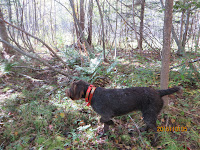Christmas
Day was quiet at Camp Grouse. Family was far away and friends were busy. We
unwrapped presents early then ate a giant breakfast. The weather looked perfect,
so we opted for a day outside with the dogs. It certainly wasn’t our first
Christmas spent in the woods.
Around
Camp Grouse the snow looked a bit thin, so we drove north where the land is a
little higher. Sure enough, the snow depth more than doubled to maybe eight or ten inches. We
stopped beside an old logging road with fat tire tracks in it. Those tracks
would make walking easier.
One
of the treats that day was finding a recently abandoned ruffed grouse snow
roost.
 |
| A ruffed grouse snow angel. |
When
the temperatures drop ruffed grouse seek shelter in the boughs of softwood
trees or down inside soft snow. The R value of snow depends on the moisture
content, but usually is around 1 per inch, about the same as wood. The R value
of those rigid closed-cell foam panels is somewhere around 5 per inch. A bird hiding
under a foot of snow would be sheltered by an R value of 12. Add to that the
protection from the wind and you can see why grouse love to bury in the snow.
One
possible catastrophe for grouse is freezing rain or sleet that traps the bird
under the snow. Hawks are unlikely to find a grouse hiding in the snow, but some
predators, like coyotes or foxes, may smell their presence. Of course guessing
where to dive into the snow to snatch a ruffed grouse requires a bit of luck. I
have also heard of birds diving into the snow and hitting an object like a
stump or rock, resulting in a broken neck. The odds of finding a dead grouse
before a wild scavenger does are long.
When
someone says to me “Go take a hike”, we generally do.

















































